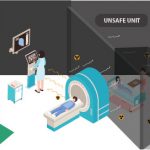Why radiation protection is a mandate for Computed Tomography units?
– Disastrous effects of unprotected diagnostic radiology.
Medical units and diagnostic centres are using equipment like X-ray machines every day. The technique of medical imaging by using special kind of X-ray is well known as ‘tomography’ in the field of health physics. As this process involves the application of moderate doses of X-ray radiation, it exposes human beings (workers and patients) inside the diagnostic centres directly to radiation, the effects of which can bring forth fatal health hazards.
Health physics promotes the science of a safe application of ionizing radiation in health care units which practise diagnostic radiology. So if computed tomography is being performed in your clinic, hospital or laboratory, you must adopt adequate safety measures ordained by the government (AERB guidelines in India) for quality assurance in diagnostic radiology.
Workers’ health and safety is an integral responsibility of an organization, and so is the safety of patients who come to receive treatment and care. Research states that exposure to a high dose of ionizing radiation can cause carcinogenic diseases, affects women during pregnancy and is detrimental to the growth of foetus.
We cannot however fully avoid the presence of ionizing radiation in medical units since X-ray application plays vital role in tomography and a nominal amount of it is endurable by living tissue. What medical units need to look after is that, people and surroundings are facilitated with appropriate radiation protection services. Health physics recommends specific quality assurance programs in diagnostic radiology.
The most prominent radiation safety services in diagnostic units include:
• Use of Radiological Protection Instruments for Effective Detection & Measurement:
These are source detection and measurement devices which are efficient in signifying the emission zone and its level. Accordingly, personal safety equipment can be used. There are various types of instruments like ‘survey meters’, ‘airborne contamination monitor’, ‘personnel exit monitors’, ‘Gamma interlock monitors’, ‘scintillation monitors’. Instruments can be both installed and portable types.
• Executing Dosimetry to Secure Employee Health and Safety:
A dosimeter is an equipment which is put on by the user to measure the dosage of radiation being received. Advanced dosimetry helps to carry out tomography services smoothly and safely without jeopardizing the biological conditions of involved personnel. Some popularly used wearable dosimeters are ‘TLD badges’, ‘quartz fiber dosimeter’, ‘film badge dosimeter’, ‘thermoluminescent dosimeter’.
Keen on learning more about dosimetry, radiological protection instruments and scope of health physics in India? Click for illustrations.






